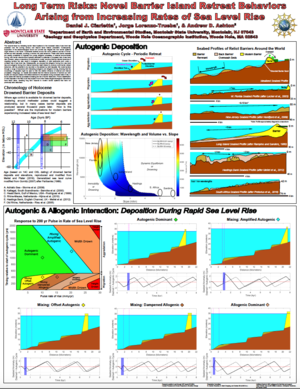2018 CSDMS meeting-057
Log in (or create account for non-CSDMS members)
Forgot username? Search or email:CSDMSweb@colorado.edu
Browse abstracts
Long Term Risks: Novel Barrier Island Retreat Behaviors Arising from Increasing Rates of Sea Level Rise

The hazards faced by retreating barrier island systems to the increased rates of sea level rise predicted over the coming century and beyond lacks historic precedent. Consequently, exploration of the sedimentological record can provide key insights into how barrier systems might behave in the future. Continental shelves around the world preserve records of former barriers as relict deposits, providing a window into past behaviors. These relict barrier deposits are usually considered to originate from purely allogenic processes, or external environmental forcing, with barrier abandonment typically attributed to episodes of increased rate of sea level rise. However, using a cross-shore morphodynamic model, we show that the internal dynamics of migrating barriers can also result in autogenic deposition of relict sediments even under a constant rate of sea level rise. Subsequently, we propose that allogenic forcing from sea level rise and autogenic forcing from internal dynamics might interact to produce novel barrier retreat behaviors, with the potential to be recorded on the seabed by relict deposits. We model barriers through a range of scenarios with interacting autogenic and allogenic forcing, showing that the morphology of deposits might be used to infer the relative influence of external and internal processes. Intriguingly, our results demonstrate that the internal dynamics of barriers can both amplify and dampen losses of shoreface sediment to the seabed during increased rates of rise, in some cases with internal processes increasing the risk of barrier destruction. Future classification of relict deposits in the field could help explain if and when these allogenic/autogenic interactions have taken place, revealing long term hazards to modern barrier systems that have not previously been described.
